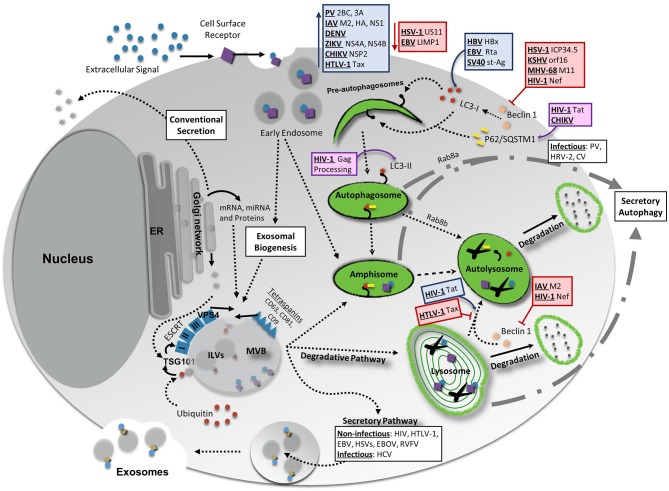Figure 1.
Interaction Between Vesicular Release Pathways, Autophagy, and Viral Infection. Several vesicle release pathways are utilized to maintain cellular homeostasis including the exosomal release pathway and secretory autophagy. Both pathways are capable of secreting viral products, although exosomes primarily secret non-infectious viral products with the exception of hepatitis C virus (HCV). Secretory autophagy has been shown to be responsible for the secretion of infectious particles in several cases. Degradative pathways include breakdown of select materials by fusion of autophagosomes, amphisomes, multivesicular bodies (MVBs), or endosomes with lysosomes. Up- or down-regulation of one of these pathways could potentially have feedback into other vesicular release or degradative systems to maintain cellular equilibrium. Degradative autophagy plays pro-viral and anti-viral roles during infection at various stages of autophagy. Red lines indicate a decrease/inhibition of autophagy by listed viral proteins, whereas blue arrows indicate a virally-induced increase or upregulation of autophagy. Viral proteins and viruses in purple boxes are targeted for degradation by the indicated portion of the autophagy pathway. For more detailed information, please see the main text. HIV-1, human immunodeficiency virus 1; CHIKV, chikungunya virus; HBV, hepatitis B virus; EBV, Epstein-Barr virus; SV40, simian virus 40; PV, poliovirus; IAV, influenza A virus; DENV, dengue virus; ZIKV, Zika virus; HTLV-1, human T-cell leukemia virus 1; HSV-1, herpes simplex virus type-1; KSHV, Kaposi's sarcoma-associated herpesvirus; MHV-68, murine gammaherpersirus 68.

